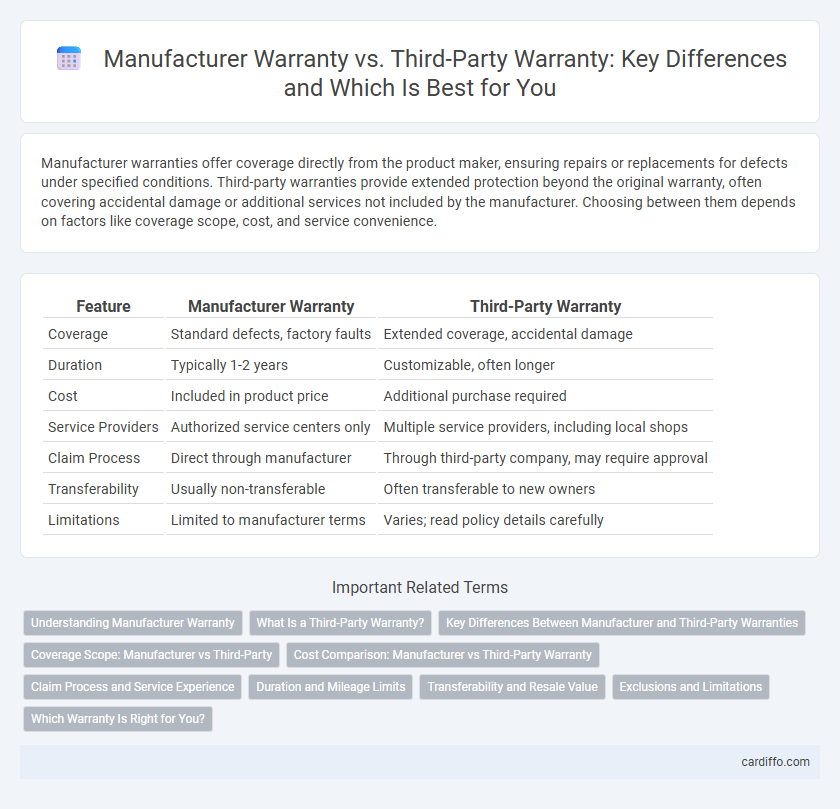Manufacturer warranties offer coverage directly from the product maker, ensuring repairs or replacements for defects under specified conditions. Third-party warranties provide extended protection beyond the original warranty, often covering accidental damage or additional services not included by the manufacturer. Choosing between them depends on factors like coverage scope, cost, and service convenience.
Table of Comparison
| Feature | Manufacturer Warranty | Third-Party Warranty |
|---|---|---|
| Coverage | Standard defects, factory faults | Extended coverage, accidental damage |
| Duration | Typically 1-2 years | Customizable, often longer |
| Cost | Included in product price | Additional purchase required |
| Service Providers | Authorized service centers only | Multiple service providers, including local shops |
| Claim Process | Direct through manufacturer | Through third-party company, may require approval |
| Transferability | Usually non-transferable | Often transferable to new owners |
| Limitations | Limited to manufacturer terms | Varies; read policy details carefully |
Understanding Manufacturer Warranty
Manufacturer warranty offers direct coverage from the product maker, ensuring repairs or replacements for defects under specific conditions and timeframes. This warranty typically covers parts, labor, and materials, providing confidence in product reliability backed by the manufacturer's expertise. Understanding the scope and limitations of a manufacturer warranty helps consumers make informed decisions about product protection and after-sales support.
What Is a Third-Party Warranty?
A third-party warranty is an extended service agreement provided by an independent company rather than the original product manufacturer. It covers repairs or replacements beyond the standard manufacturer warranty, often offering customizable coverage options for electronics, appliances, or vehicles. Consumers choose third-party warranties to extend protections, potentially saving on repair costs after the manufacturer's warranty expires.
Key Differences Between Manufacturer and Third-Party Warranties
Manufacturer warranties typically offer direct coverage from the product maker, ensuring authentic repairs and part replacements within a specified period, often at no extra cost. Third-party warranties, provided by independent companies, may cover an extended range of services or longer durations but can vary significantly in terms of coverage limits, claim procedures, and customer service quality. Understanding the distinctions in claim approvals, repair sources, and cost implications is crucial for making informed decisions when considering warranty options.
Coverage Scope: Manufacturer vs Third-Party
Manufacturer warranties typically offer comprehensive coverage that directly addresses defects in materials and workmanship for a specified period, ensuring repairs or replacements are handled by authorized service providers using genuine parts. Third-party warranties often provide extended coverage options that may include accidental damage, wear and tear, and broader protection beyond the manufacturer's scope, but service quality and claim processes can vary significantly. Consumers should carefully compare coverage limits, exclusions, and claim procedures to select the warranty that best meets their product protection needs.
Cost Comparison: Manufacturer vs Third-Party Warranty
Manufacturer warranties typically come included with the product at no additional cost, covering repairs and replacements within a specific period and often featuring strict terms and authorized service centers. Third-party warranties, usually purchased separately, often offer lower upfront costs and more flexible coverage options but may include deductibles, service fees, or limited repair networks. Comparing costs requires evaluating upfront payments against potential out-of-pocket expenses and coverage scope to determine the most cost-effective solution.
Claim Process and Service Experience
Manufacturer warranties typically offer a streamlined claim process managed directly by the brand, ensuring authorized service centers handle repairs with genuine parts. Third-party warranties may provide more flexible coverage options but often involve longer claim processing times and varied service quality due to independent repair networks. Choosing manufacturer warranties usually results in faster service and more reliable repairs, while third-party warranties can offer cost savings at the expense of consistency.
Duration and Mileage Limits
Manufacturer warranties typically offer coverage ranging from 3 to 7 years or 36,000 to 100,000 miles, providing protection backed directly by the vehicle maker. Third-party warranties may extend coverage beyond manufacturer limits but often impose stricter mileage caps and shorter duration terms. Evaluating the balance between duration and mileage limits is crucial for maximizing long-term vehicle protection.
Transferability and Resale Value
Manufacturer warranties typically offer transferability, enhancing the resale value by providing future buyers with confidence in product coverage. Third-party warranties often lack transferability, which can diminish the item's appeal and lower its resale price. Ensuring a transferable manufacturer warranty adds significant value and trust when reselling products.
Exclusions and Limitations
Manufacturer warranties typically cover defects in materials and workmanship but exclude damage from misuse, unauthorized repairs, or normal wear and tear, ensuring limited scope of protection tied directly to the brand's quality standards. Third-party warranties often provide broader coverage, including accidental damage and extended service periods, but they may impose stricter claim procedures and exclusions related to product modifications or pre-existing conditions. Understanding the specific exclusions and limitations of both warranty types is essential to avoid unexpected repair costs and to maximize coverage benefits.
Which Warranty Is Right for You?
Manufacturer warranties offer direct coverage from the product creator, ensuring authentic parts and repairs, often with no extra cost during the warranty period. Third-party warranties provide extended protection beyond the manufacturer's terms, ideal for customers seeking longer or more comprehensive coverage. Choosing the right warranty depends on product value, usage frequency, and desired service scope, balancing manufacturer reliability against third-party flexibility.
Manufacturer Warranty vs Third-Party Warranty Infographic

 cardiffo.com
cardiffo.com